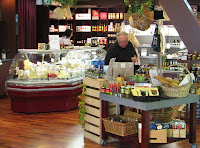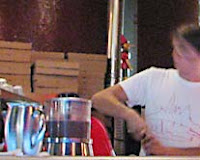Shops we love: Kirkcaldie & Stains Cuisine
It's been quite a while since I wrote a "shops we love" post, I guess because there haven't been that many new shops that I could honestly say I regularly patronised. But while there's been plenty of talk about new specialty food stores (Zarbo at Chaffers Dock, the expansion of Moore Wilson, La Cloche), a comprehensive fine food emporium has been stealthily taking shape on Lambton Quay.
 I've always thought that Kirkcaldie & Stains was a bit dowdy and fusty, and could benefit from the sort of reinvention that Selfridges has gone through (though that might alienate their core market of K-block matrons and Wairarapa farmers' wives). Their Cuisine store, which has been growing like a particularly delicious fungus through the neighbouring Harbour City Centre, is a different story. What started as a posh kitchenware outlet with a small deli has now sprouted separate shops for cheese, chocolate, tea, coffee, pantry items and wine: pretty much all the essentials of life.
I've always thought that Kirkcaldie & Stains was a bit dowdy and fusty, and could benefit from the sort of reinvention that Selfridges has gone through (though that might alienate their core market of K-block matrons and Wairarapa farmers' wives). Their Cuisine store, which has been growing like a particularly delicious fungus through the neighbouring Harbour City Centre, is a different story. What started as a posh kitchenware outlet with a small deli has now sprouted separate shops for cheese, chocolate, tea, coffee, pantry items and wine: pretty much all the essentials of life.Okay, that may be a slight exaggeration (they don't yet sell hard liquor), and the selection and prices don't exactly lend themselves to shopping for everyday staples. But it's nevertheless a droolworthy cornucopia of special-occasion goodies, with the presentation and service to match. One of my favourite sections would have to be the fromagerie, where the cheeses are labelled with maps indicating their provenance and individually wrapped with hand-written notes when you purchase. The staff know what they're talking about, and will happily offer you samples to make sure that you are getting what you want for a specific purpose: for instance, when I ordered some spectacular-looking Shropshire Blue, the attendant suggested that while it would go superbly with onions, it might be too salty for a cheeseboard: after tasting, I agreed and went with her suggestion of a Whitestone Blue instead.
As one might expect, one could do serious damage to one's "food miles" budget here. Nevertheless, they have made the admirable decision to stock almost entirely local wines (except for Champagne, of course), and the cheese maps help you make an informed decision about where your food is coming from. I think insisting on a "100-mile diet" is far too extreme, anyway, and while it's ridiculously extravagant to live on out-of-season produce flown from the other hemisphere, there's nothing wrong with the occasional exotic treat. Apart from anything else, it helps us broaden our palates and appreciate the different qualities of our local foods.
It's not quite the local food market that I've been promoting for a while, but it's getting closer and it's one of the best shops on the increasingly chain-ridden Lambton Quay. Rather than an upmarket food hall like this, I'd love it if its role were fulfilled by dozens of small, independent, unpretentious specialist shops throughout the city: from the Basin to Thorndon, you'd never be more than a couple of blocks from all the bread, cheese, meat, drink and fresh produce you'd need. While our shopping habits may have been permanently altered by the convenience and predictability of supermarkets, it may be that with the increasing residential population of central Wellington, that sort of vision is getting closer by the day.



























